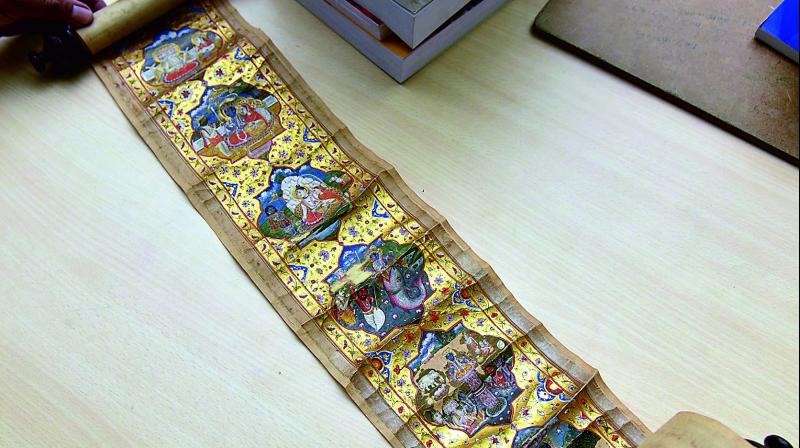Osmania University's rare manuscripts revealed
They are a part of the collection of the main library of the university, which was established in 1918.

Hyderabad: Osmania University has a collection of rare ancient manuscripts and books, among them two manuscripts of the epic Mahabharata in Telugu on palm leaves, and the Bhagavata, which promotes the devotion of Krishna, integrating themes of the Advaita (monism) philosophy of Adi Shankara.
They are a part of the collection of the main library of the university, which was established in 1918, the same time as the university itself. The library was later shifted to the present building, which was inaugurated by then President Dr S. Radhakrishnan on August 3, 1963.
The Mahabharata manuscripts are of different sizes: one is 18 inches x 6 inches and the other, 20 inches x 10.1/4 inches. One of the manuscripts has almost the whole text of the Mahabharata with Nilakantha’s commentary.
Nilakantha Cathurdhara was a scholar who lived in Varanasi in the latter half of the 17th century and was famous for his commentaries on the Mahabharata. Each page of the manuscript has a distinctive gold and silver border interspersed with floral designs and contains miniature paintings of the characters mentioned in the text on that particular age.
The manuscript contains two dates, one in the beginning — Saka 1722 (1800 AD) and the other at the end — Saka 1751 (1829 AD), which suggests that it took 29 years for the manuscript to be copied and illustrated!
The second manuscript does not cover the whole text, but there is one bundle of Bhishma Parva, which requires special mention. It contains the Bhagavad Gita with three commentaries, the text occupying the middle and the three commentaries in the upper and lower portions, ornamented with floral borders.
There are miniature paintings of Krishna and Arjuna on each page of this manuscript. Though the manuscript is over 150 years old, the colours are fresh.
A note in the manuscript states that it was copied at Bhagyanagar (Hyderabad) on the banks of the Muchkunda (Musi).
The Bhagavata manuscript in Sanskrit has an illustrated scroll of the complete text of the 12 Skandhas of Srimad Bhagavata. The scroll is four inches wide and 64 feet long.
It’s a unique manuscript of the Dasama Skanda of Bhagavatha and is profusely illustrated with commentary of Sridhara Swami. Krishna Leela is depicted with exquisite beauty on the pages. There are pictures of Rasakrida. The borders are in gold.
The first 64 inches contain miniature paintings of Ganesha, Saraswathi, Lakshmi-Narayana, Shiva-Parvathi and the 10 avatars of Vishnu. At the end, there are paintings of Sukha and Parikshit.
The skandas are separated by miniature paintings; there are other smaller miniatures in between each skandha. The scroll is an excellent example of the calligraphic art. Most of the manuscripts in the library's collection have been microfilmed and descriptive catalogues of manuscripts in Sanskrit, Kannada and Marathi have been published.
"The OU library has 6,825 rare manuscripts, including palm leaf manuscripts, in Arabic, Hebrew, Hindi, Kannada, Marathi, Persian, Sanskrit, Tamil, Telugu, Turkish and Urdu, covering a variety of subjects. In all, the library has 5,43,579 books besides other literature," says Fazaluddin Ahmed, library assistant.
The Juma-Ali-Masjid Centre for Culture and Heritage in Dubai has undertaken digitisation of the manuscripts at the OU library and work is in progress.
Tribute to poetess part of collection
A sort of authorised biography of Mah Laqa Bai, the famed poetess in the court of the second Nizam, Nizam Ali Khan, is part of the Osmania University library’s collection.
Mah Laqa Bai held the Adikmet Jagir on which the present Osmania University campus is located in Hyderabad. According to historical accounts, Mah Laqa Bai was awarded the Adikmet (meaning “supreme height”) jagir of 1,600 acres by the Nizam.
Gulam Husain Khan Jawher wrote a 270-page book titled Tajalliyat-I-Mahlaqa, in Persian, on the famed poetess whose pen name was "Chanda".
The book covers the history of the Asaf Jahi dynasty of Hyderabad. In the introduction to the book, the author states that Mah Laqa Bai herself instructed him to compile this work.Mah Laqa Bai, Adikmet Jagir, Osmania University, poetess collection, Tajalliyat-I-Mahlaqa.

